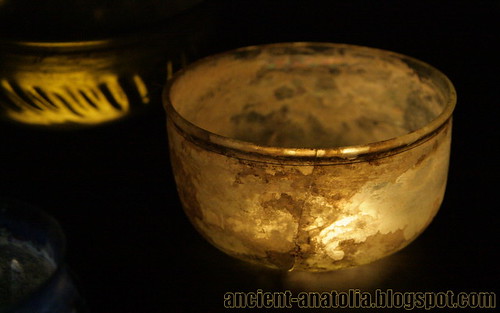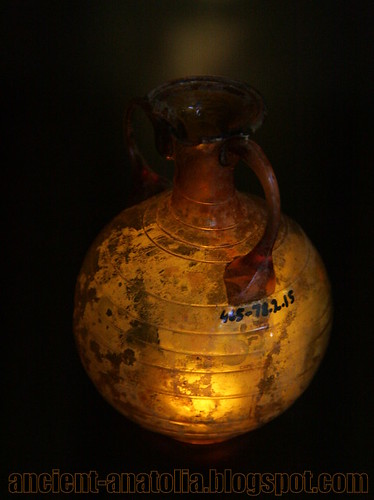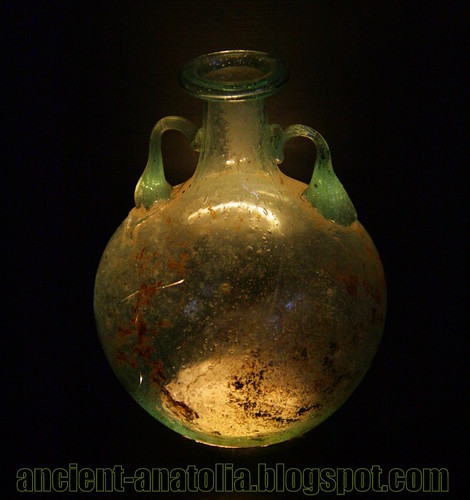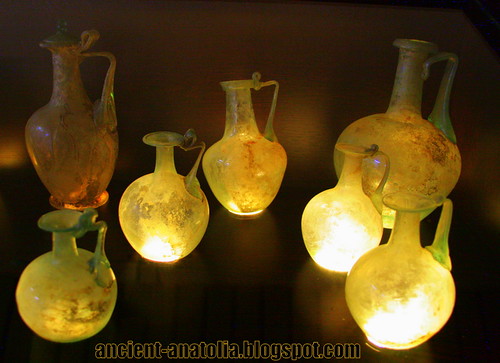
The history of creating glass can be traced back to 3500 BCE in Mesopotamia. Roman glass objects have been recovered across the Roman Empire in domestic, industrial and funerary contexts.
 Glass was used primarily for the production of vessels, although mosaic tiles and window glass were also produced. Roman glass production developed from Hellenistic technical traditions, initially concentrating on the production of intensely coloured cast glass vessels. However, during the 1st century AD the industry underwent rapid technical growth that saw the introduction of glass blowing and the dominance of colourless or ‘aqua’ glasses. Production of raw glass was undertaken in geographically separate locations to the working of glass into finished vessels, and by the end of the 1st century AD large scale manufacturing resulted in the establishment of glass as a commonly available material in the Roman world, and one which also had technically very difficult specialized types of luxury glass, which must have been very expensive.
Glass was used primarily for the production of vessels, although mosaic tiles and window glass were also produced. Roman glass production developed from Hellenistic technical traditions, initially concentrating on the production of intensely coloured cast glass vessels. However, during the 1st century AD the industry underwent rapid technical growth that saw the introduction of glass blowing and the dominance of colourless or ‘aqua’ glasses. Production of raw glass was undertaken in geographically separate locations to the working of glass into finished vessels, and by the end of the 1st century AD large scale manufacturing resulted in the establishment of glass as a commonly available material in the Roman world, and one which also had technically very difficult specialized types of luxury glass, which must have been very expensive.
Glassblowing technique
Glassblowing is a glass forming technique which was invented by the Phoenicians at approximately 50 BC somewhere along the Syro-Palestinian coast. The earliest evidence of glassblowing comes from a collection of waste from a glass workshop, including fragments of glass tubes, glass rods and tiny blown bottles, which was dumped in a mikvah, a ritual bath in the Jewish Quarter of Old City of Jerusalem dated from 37 to 4 BC. Some of the glass tubes recovered are fire-closed at one end and are partially inflated by blowing through the open end while still hot to form small bottle, thus they are considered as a rudimentary form of blowpipe. Hence, tube blowing not only represents the initial attempts of experimentation by glassworkers at blowing glass, it is also a revolutionary step that induced a change in conception and a deep understanding of glass. Such invention swiftly eclipsed all other traditional methods, such as casting and core-forming, in working glass.

In the Roman Empire
The invention of glassblowing coincided with the establishment of the Roman Empire in the 1st century BC which served to provide motivation to its spread and dominance. Glassblowing was greatly encouraged under the Roman rule, although Roman citizens could not be "in trade", in particular under the reign of Augustus, therefore glass was being blown in many areas of the Roman world. On the eastern borders of the Empire, the first glass workshops were set up by the Phoenicians in the birthplace of glassblowing in contemporary Lebanon, Israel, and Palestine, as well as in the neighbouring province of Cyprus. Ennion for example, was among one of the most prominent glassworkers from Lebanon of the time. He was renowned for producing the multi-paneled mould-blown glass vessels that were complex in their shapes, arrangement and decorative motifs. The complexity of designs of these mould-blown glass vessels illustrated that the sophistication of the glassworkers in the eastern regions of the Roman Empire. Mould-blown glass vessels manufactured by the workshops of Ennion and other contemporary glassworkers such as Jason, Nikon, Aristeas and Meges, constitutes some of the earliest evidence of glassblowing found in the eastern territories. Meanwhile, the glassblowing technique reached Egypt and was described in a fragmentary poem printed on the papyrus which was dated to 3rd century AD. Besides, the Roman hegemony over the Mediterranean areas resulted in the substitution of Hellenistic casting, core-forming and mosaic fusion techniques by blowing. The earliest evidence of blowing in Hellenistic consists of small blown bottles for perfume and oil retrieved from the glass workshops on the Greek island of Samothrace and at Corinth in mainland Greece which were dated to 1st century AD.
On the other hand, the Phoenician glassworkers exploited their glassblowing techniques and set up their workshops in the western territories of the Roman Empire first in Italy by the middle of the 1st century AD Rome, the heartland of the Empire, soon became a major glassblowing centre and more glassblowing workshops were subsequently established in other provinces of Italy, for example Campania, Morgantina and Aquileia. A great variety of blown glass objects, ranging from unguentaria (toiletry container for perfume) to cameo, from tableware to window glass, were produced. From there, escaping craftsmen forbidden to travel otherwise advanced to the rest of Europe by building their glassblowing workshops in the north of the Alps which is now Switzerland and then at sites in northern Europe in present-day France and Belgium. Surviving evidence, such as blowpipes and moulds which are indicative of the presence of blowing, was fragmentary and limited. Fragments of clay blowpipes were retrieved from the late 1st century AD glass workshop at Avenches in Switzerland. Clay blowpipes, also known as mouthblowers, were made by the ancient glassworkers due to the accessibility and availability of the resources before the introduction of the metal blowpipes. Hollow iron rods, together with blown vessel fragments and glass waste dating to approximately 4th century AD, were recovered from the glass workshop in Merida of Spain, as well as in Salona in Croatia. Meanwhile, one of the most prolific glassblowing centres of the Roman period was established in Cologne on the river Rhine in Germany by late 1st century BC. Stone base mould and terracotta base mould were discovered from these Rhineland workshops suggesting the adoption and the application of mould-blowing technique by the glassworkers. Besides, blown flagons and blown jars decorated with ribbing, as well as blown perfume bottles with letters CCAA or CCA which stand for Colonia Claudia Agrippiniensis, were produced from the Rhineland workshops. Remains of blown blue-green glass vessels, for example bottles with a handle, collared bowls and indented beakers, were found in abundance from the local glass workshops at Poetovio and Celeia in Slovenia.
Photos: Roman glass objects of centuries 1st-4th at Cankiri Museum of Archaeology, Turkey.
More about ancient glass work...